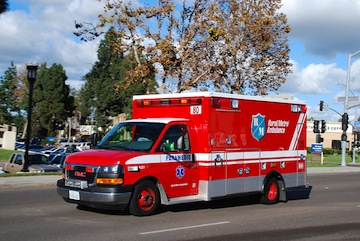Daily Business Report-Oct. 11, 2017
All of the district’s campuses, including San Diego Miramar College shown here, have benefitted from a $1.555 billion bond construction program that generated the equivalent of 366 full-time jobs in 2016-17.
San Diego Community College District
Economic Impact Reaches $3.7 Billion in 2016-17
The San Diego Community College District (SDCCD) contributed approximately $3.7 billion in net spending – or 1.8 percent of the county’s total gross regional product – during the 2016-17 fiscal year, according to a new report from an Idaho-based economic modeling firm.
The Emsi study also found the economic impact of former students who are employed in the San Diego County workforce amounted to $3.1 billion in added income to the regional economy, enough to support 35,735 jobs. A student who earns an associate degree from the SDCCD can expect to earn on average approximately $11,000 more annually than someone with just a high school diploma at the midpoint of their working career. Over a working lifetime, that increase in earnings amounts to approximately $407,000 in added income.
A number of former SDCCD students now own and operate their own business. Examples include former San Diego City College student Michael Taylor, who runs NWB Environmental Services, a cultural resource management firm that contracts with utility companies and private industry to monitor construction projects to mitigate damage to archaeological finds, and Olena Shaber, a former Mesa College interior design student who opened O Interiors and Coronado Kitchen and Bath.
In all, the district’s economic impact supports more than 46,000 jobs, including nearly 2,500 in manufacturing, more than 4,200 in professional and technical services, and more than 5,400 in the health care and social assistance sectors.
“The San Diego Community College District is the great equalizer of economic and social mobility. The district provides any student who is seeking a degree or certificate and any employee who is seeking advancement in the workplace an opportunity to reach their goals,” said SDCCD Chancellor Constance M. Carroll. “This report also shows that the district is having a profound impact and playing a pivotal role in the economy.”
_______________

County Supervisors Vote to Restrict
Drones Near Fire Locations
The San Diego County Board of Supervisors voted Tuesday to restrict drones from flying near or over fires and locations that have public safety temporary area restrictions to ensure public safety.
The emergency ordinance, passed during peak fire season, applies to the unincorporated areas of San Diego County and takes effect immediately. It will restrict civilian drones from launching, flying or landing within three miles of a firefighting operation or a designated area with temporary restrictions. Any violation would be a misdemeanor crime. All board members present voted in favor of the ordinance.
The ordinance will give news media an exception to cover a disaster area as a way to inform the public, as long as it does not interfere with emergency operations.
In wildfire situations, the presence of a civilian drone in an area where aerial firefighting resources are flying interferes with emergency operations. If a civilian drone is seen in the area, it results in the immediate grounding of firefighting helicopters or planes until the drone can be removed. This action is for firefighter safety which includes preventing mid-air collisions in conditions where visibility is often murky due to smoke. Since water drops from the air are one of a fire agency’s best tools to stop or reduce flames, the withdrawal of air resources leaves a fire to grow putting lives and property at risk.
Law enforcement can also designate a temporary area restriction, in situations of potential unrest such as the prototype border wall construction project in Otay Mesa. Objects that could be used as weapons are prohibited in a temporary area restriction. In these situations, the Sheriff’s Department or other law enforcement, may need to operate a helicopter or drone to monitor the area, so civilian drones would interfere with public safety.
_______________
Triple-Digit Rent Increases
Forecast for Southern California
the USC Lusk Center for Real Estate projects triple-digit rent increases for apartment dwellers across much of the Southern California region over the next two years. Renters in Los Angeles County, Orange County and San Diego County, as well as the Inland Empire, will experience rent increases ranging from $110 to nearly $150/month during that time. Ventura County will see just under $100 increases.
_______________
County to Join Legal Effort
to Stop Border Sewage Spills
The San Diego County Board of Supervisors has voted to file a notice of intent to sue to stop damaging sewage spills that have fouled the Tijuana River Valley and nearby beaches.
“Enough is enough,” said Supervisor Cox, who represents the area. “We’ve exhausted all our efforts to resolve this terrible situation and it’s time we force those responsible to once and for all fix this problem.”
The board voted in closed session Tuesday to join a growing legal effort against the U.S. Section of the International Boundary and Water Commission, a government agency that applies the boundary and water treaties of the United States and Mexico.
In February, a sewage spill from Mexico estimated by some sources to have been more than 143 million gallons, fouled the Tijuana River Valley and resulted in the temporary closure of beaches from Imperial Beach to Coronado due to the high levels of pollution. After that, the city of Imperial Beach, joined later by Chula Vista and the Port of San Diego, filed a notice of intent to sue the IBWC and one of its contractors for violations of the federal Clean Water Act and Resource Conservation and Recovery Act. The City of San Diego also joined that effort last week.
_______________
San Diegan Named Finalist in SBA
InnovateHER Business Challenge
Jenna Ryan of Uqora LLC in San Diego has been named one of 10 finalists for the U.S. Small Business Administration’s InnovateHER Business Challenge, the nationwide competition highlighting innovative products, services or technology developed by visionary entrepreneurs that have a measurable impact on the lives of women and families, and in the marketplace. The finalists were announced by Administrator Linda McMahon, the head of the U.S. SBA.
The 10 finalists were selected through a nationwide competition held by host organizations, including universities, accelerators, and SBA Resource Partners that ran local area competitions through June 3, 2017. Next, an executive committee of SBA officials evaluated more than 120 semi-finalist nominations and chose 10 finalists to participate in the National Pitch Competition, whose products and services best meet the competition criteria and present the greatest potential for success.
The InnovateHER Business Challenge finalists are invited to conduct a marketing pitch before a team of expert judges at the National Pitch Competition held on Oct. 26 in Washington, D.C., as they compete for the top three awards totaling $70,000 in prize money, provided by the Sara Blakely Foundation.
Ryan’s Uqora gives women the defense they need against bacteria that causes urinary tract infections, keeping them out of the doctor’s office and off antibiotics.
General Atomics Transitions from the
MQ-1C Gray Eagle Drone to Long-Range Version
General Atomics Aeronautical Systems, Inc. officially transitioned its production line from the MQ-1C Gray Eagle to its new long-range variant, the MQ-1C ER Gray Eagle Extended Range following the completion of the last contracted MQ-1C aircraft.
GA-ASI’s investment in airframe composite tooling enabled the company to start manufacturing the MQ-1C ER ahead of schedule, with its production running in parallel with the MQ-1C line. The first four MQ-1C ER aircraft are now being used for developmental testing that will lead to follow-on operational test and evaluation in spring 2018. Customer deliveries of MQ-1C ER will begin in summer 2018.
The MQ-1C Gray Eagle UAS has been fielded to 12 U.S. Army operational units and has accumulated more than 290,000 flight hours. The MQ-1C is the Army’s most active kinetic platform in theater.
“We are proud of our many years of effort to complete the factory build of 165 MQ-1C Gray Eagles for the U.S. Army,” said David R. Alexander, president, Aircraft Systems, GA-ASI. “We’re now focused on delivering the Gray Eagle ER and believe its endurance and other improved capabilities will be a game changer on the battlefield.”




